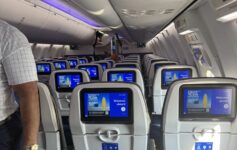
Ronald Reagan Washington National Airport, just minutes from downtown Washington DC, is subject to a perimeter rule that restricts all but a handful of flights beyond 1,250 miles. A push this week to extend the perimeter to 1,475 miles failed — and United Airlines played a part in it.
Why an increase of 175 miles? Rep. Blake Farenthold (R-Texas) serves the Corpus Christi area and proposed this slight perimeter extension for the noble purpose of inviting direct service to DCA from his hometown airport, CRP (currently served by Southwest to Chicago and Houston, AA to Dallas, and United to Houston).
The usual bipartisan suspects, Delegate Eleanor Holmes Norton (D-DC) and Rep. Barbara Comstock (R-Virginia), opposed the motion on the grounds it would add to noise and congestion at DCA (an odd assertion considering the airport would still be slot-controlled) and a hometown airline was also instrumental in blocking this bill.
By its own admission in an employee memo:
United’s Congressional Affairs team worked with Chairman Bill Shuster (R-PA) and several Republicans and Democrats on the House Transportation Committee to oppose the amendment.
Why would United oppose this rule? That’s easy, it maintains a hub at nearby Washington Dulles.
The perimeter rule at National Airport dates back to 1969, when Washington Dulles was just starting out and Congress (which maintains control over the affairs of DC, that whole taxation without representation thing you see on DC licence plates…) wanted to cultivate IAD into an international airport and keep DCA as regional airport. Slot restrictions at DCA were introduced and the perimeter rules remains on the books, having been modified three times to add “exemptions” for airports beyond the perimeter:
- 2000: 24 slot exemptions
- 2003: 22 slot exemptions
- 2012: 8 slot exemptions
United opposed any effort to eliminate the perimeter rule and opposed these exemptions while also taking advantage of them (United serves DCA non-stop from San Francisco and Denver, both exemptions).
But United wants to have its cake and eat it too:
“We thank Reps. Comstock and Norton for preserving the complementary roles of DCA and IAD, an arrangement that has served the Washington market well for some 30 years,” said Congressional Affairs VP Nancy Van Duyne.
Though United is careful to phrase it in more customer-friendly terms:
The current perimeter rule ensures many smaller markets in the eastern U.S. continue to have non-stop air service to the nation’s capital and that IAD remains the region’s international hub airport. Without it, airlines at DCA would have a strong economic incentive to substitute more profitable long-haul service to large West Coast markets, while drawing traffic away from United’s Dulles hub.
Well, that would be correct. The Silver Line still has not reached Dulles and even when it does DCA will remain oh so much more convenient.
It is not surprising or even noteworthy that United wants to protect its Washington Dulles hub from competition. There is just one thing I don’t quite understand–
What does flight distance have to do with noise and congestion? Wouldn’t the more logical response to overcrowding be to limit slots or aircraft type rather than destination? Sure, many of the shorter flights out of DCA are on regional jets, but those are often louder and cause more congestion because they are the first to be delayed or cancelled when air space gets crowded or weather turns bad. Is Alaska’s 2,451-miles daily 737-700 flight to Los Angeles any louder or more congested than United’s 757-300 flight to Denver or Delta’s 757-200 to New York?
It is true that if DCA opened up we might see scheduled transatlantic service on a 757 or 767 (largest aircraft DCA can handle) to Europe, but that is unlikely — the infrastructure is just not there (though Boston’s third-world E-Terminal shows us that anything is possible) and the airport would remain slot-restricted. Dulles works has a hub because it has so much feeder traffic from across the country, something DCA would never rival with merely the elimination of the perimeter rule.
I hope that one day we will see an end to the perimeter rule, just as we saw the end to the Wright Amendment’s perimeter rule at Dallas Love Field. Until then, though, look for United and other entrenched interests to use any possible argument, no matter how spurious, to oppose change.




Off topic – the symbol on the floor in the center of the picture looks (to this old paramedic) to be the Star of Life, part of EMS identification for decades (https://en.wikipedia.org/wiki/Star_of_Life). When last I was in DCA I didn’t notice it. Might it have been for a special occasion? Perhaps it’s another, more generic, symbol.
As a local resident, I strongly oppose the further relaxation of the DCA perimeter rule, and favor revoking all slot and perimeter exemptions at DCA. The relaxation of the perimeter rule has led to the “Narita-ization” of Dulles. How well has that served customers in Tokyo? The ideal would be an airport that is conveniently located and large enough to consolidate all services, but there is not enough space inside the beltway. The split model, used in New York, Dallas, Chicago and Houston works well.
If United wants to protect its Dulles hub, it should push for the new C/D terminal at Dulles.
According to Wikipedia (and others), the perimeter rule was thought by the FAA to reduce noise because aircraft could take off with less fuel, thereby taking off lighter and climbing faster reduce engine noise.